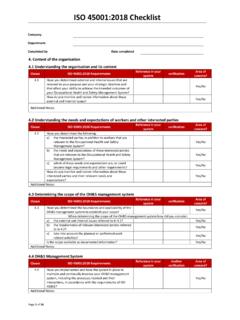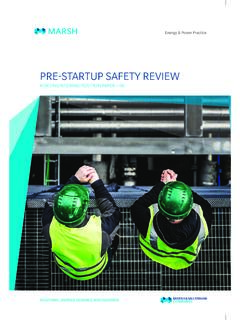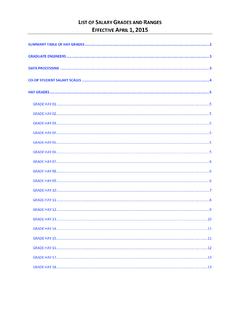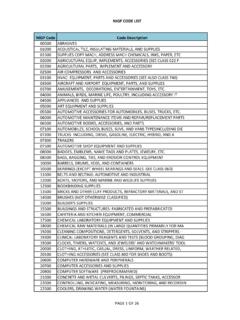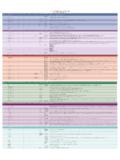Transcription of OCCUPATIONAL HYGIENE AND RISK MANAGEMENT
1 OCCUPATIONAL HYGIENEAND RISK MANAGEMENT00 Chapter 00 Prelims 31/1/04 9:17 AM Page i00 Chapter 00 Prelims 31/1/04 9:17 AM Page iiOCCUPATIONAL HYGIENEAND RISK MANAGEMENTS econd editionMEGAN TRANTER00 Chapter 00 Prelims 31/1/04 9:17 AM Page iiiCCThis edition first published in Australia in 2004 Megan Tranter 2004 The material in this book is intended for reference only. The author and publisher expresslydisclaim all liability to any person arising directly or indirectly from the use of, or from anyerrors or omissions in the content of this book. All rights reserved. No part of this book may be reproduced or transmitted in any form or byany means, electronic or mechanical, including photocopying, recording or by anyinformation storage or retrieval system, without prior permission in writing from thepublisher.
2 The Australian Copyright Act 1968(the Act) allows a maximum of one chapter or10% of this book, whichever is the greater, to be photocopied by any educational institutionfor its educational purposes provided that the educational institution (or body thatadministers it) has given a remuneration notice to Copyright Agency Limited (CAL)under the & Unwin 83 Alexander StreetCrows Nest NSW 2065 Phone:(61 2) 8425 0100 Fax:(61 2) 9906 2218 Email: Library of AustraliaCataloguing-in-Publication entry:Tranter, HYGIENE and risk 1 74114 329 Industrial HYGIENE . 2. Risk MANAGEMENT . I. : Russell BrooksTypeset in 10/12pt Amerigo by Asset Typesetting Pty by Southwood Press, 9 8 7 6 5 4 3 2 117388_new_Prelims 2/10/04 2:24 PM Page ivChapter 1 Fundamentals of occupationalhygiene and risk management1 OCCUPATIONAL hygiene1 Risk management2 Risk perception3 States of matter4To xicology8 Routes of entry9 Distribution, metabolism and excretion10 Dose11 Carcinogenicity13 Chronic versus acute exposure15 National exposure standards16 Sampling and measurement18 Types of national exposure standards18 Units of measurement20 Biological exposure indices24 Epidemiology25 Risk factors27 Summary28 Bibliography and further reading29 Chapter 2 Working out the human body31 Our bodily systems31 Cardiovascular system33 Digestive system34 Endocrine system36 Immune system37 CONTENTS17388_new_Prelims 2/10/04 2.
3 24 PM Page vIntegumentary system39 Lymphatic system41 Muscular system42 Nervous system44 Reproductive system46 Respiratory system49 Skeletal system51 Urinary system52 Anatomical positions54 Summary56 Bibliography and further reading56 Chapter 3 Hazard identification57 Inspections57 OCCUPATIONAL HYGIENE auditing60 Using information or specialist advice62 Reviewing records material safety data sheets63 Reviewing records labelling65 Summary65 Bibliography and further reading65 Chapter 4 Dusts and particulate67 Dust exposure in industry a historical review67 Definitions68 Dusts68 Size distributions of dusts71 Respirable dust monitoring75 Inspirable dust monitoring79 Total dust monitoring80 Particle size and dust characterisation monitoring80 Direct-reading monitoring equipment81 Dusts of OCCUPATIONAL HYGIENE significance81 Fibres88 Summary97 Bibliography and further reading97vi OCCUPATIONAL HYGIENE and Risk Management00 Chapter 00 Prelims 31/1/04 9.
4 17 AM Page viChapter 5 Metals99 The toxicity of metals99 Nature of contaminant and routes of entry100 Specific metals and their risks101 Summary119 Bibliography and further reading119 Chapter 6 Chemical contaminants121 The nature of gases and vapours121 Physiological effects of exposure to gases125 Simple asphyxiants125 Determining oxygen displacement from simple asphyxiants130 Chemical asphyxiants130 Irritant gases135 Solvents140 Other chemical contaminants of OCCUPATIONAL HYGIENE significance145 Confined spaces148 OCCUPATIONAL HYGIENE monitoring techniques149 Direct monitoring150 Sample collection and analysis154 Biological monitoring158 Summary159 Bibliography and further reading159 Chapter 7 Noise and vibration161 The physics of sound162 Characteristics of soundwaves163 Characteristics of sound164 Emission and immission165 The logarithmic response to sound165 How the ear hears166 Effects of exposure to noise168 Sound pressure levels, weightings and noise dose170 Measuring noise174 Conducting a noise survey178 Contents vii00 Chapter 00 Prelims 31/1/04 9:17 AM Page viiOccupational noise management180 Controlling noise transmission185 Audiometric testing188 Hearing protection devices190 Selecting hearing protection devices191 Vibration194 Health effects of exposure to vibration195 Measuring vibration195 Controlling vibration exposure198 Summary200 Bibliography and further reading200 Chapter 8 Heat and cold203 Thermoregulation.
5 Maintaining the body s equilibrium203 The effects of exposure to excessive heat204 Physiological monitoring of exposure to heat206 The effect of metabolic work rate208 Environmental monitoring of exposure to heat208 Heat stress indices212 Controls for heat218 Exposure to cold and moderately cold environments220 Summary222 Bibliography and further reading222 Chapter 9 Radiation and pressure225 Ionising radiation225 Instrumentation230 Non-ionising radiation232 Controls for radiation239 Pressure239 Summary240 Bibliography and further reading240viii OCCUPATIONAL HYGIENE and Risk Management00 Chapter 00 Prelims 31/1/04 9:17 AM Page viiiChapter 10 Biological hazards243 Human and microbial interaction243 Categories of biological agents246 Bacterial zoonoses248 Chlamydioses and rickettsioses250 Viruses251 Parasitic disease251 Fungi252 Humans as reservoirs252 Indoor air quality254 Organic dusts258 High-risk industries259 Monitoring techniques and counting259 Controls for biological hazards262 Summary266 Bibliography and further reading266 Chapter 11 Ergonomics267 Some definitions of ergonomics267 Muscular work268 Biomechanics270 Manual materials handling272 Anthropometry274 Stress276 Shift work and working hours277 Lighting278 Summary283 Bibliography and further reading283 Chapter 12 Risk analysis285 Risk and hazard285 Danger and safety286 Definition of risk
6 Analysis286 Conducting a risk assessment292 Risk perception292058014558003346882802255029 900 Contents ix17388_new_Prelims 2/10/04 2:25 PM Page ixAAAAAAAAABBBCCCCCCDDDDEEEEFAGGHHHHHIAB ias and risk perception293 Risk communication294 Summary295 Bibliography and further reading295 Chapter 13 Control297 The aims of control297 Taking a methodical approach to control298 Methods of control299 Hierarchy of control300 Ventilation305 Dilution ventilation305 Local exhaust ventilation311 Personal protective equipment318 Summary326 Bibliography and further reading326 Chapter 14 Using a systematic approach to risk management329 Managing and management329 Theories of management329 Reasons for managing OCCUPATIONAL HYGIENE risks330 Managing and motivating people333 MANAGEMENT systems335 Summary339 Bibliography and further reading340 Index341x OCCUPATIONAL HYGIENE and Risk
7 Management17388_new_Prelims 2/10/04 2:25 PM Page xAASatomic absorption spectroscopyACasbestos-cementACGIHA merican Conference of Governmental Industrial HygienistsADG CodeAustralian Dangerous Goods CodeAEDaerodynamic equivalent diameterAESatomic emission spectroscopyAETallowable exposure timeALARAas low as reasonably achievableAVManti-vibration mountingsBCIRAB ritish Cast Iron Research AssociationBEIbiological exposure indexBMRCB ritish Medical Research CouncilCCAchromated copper arsenateCETcorrected effective temperatureCFCchlorinated fluorocarbonCNScentral nervous systemCTDcumulative trauma disorderCTScarpal tunnel syndromeDBdry bulbDNAdeoxyribonucleic acidDNDdaily noise doseDSdispersion stainingECTequivalent chill temperatureEMRelectromagnetic radiationETeffective
8 TemperatureETSenvironmental tobacco smokeFAMfibrous aerosol monitorGCgas chromatographGTglobe temperatureHEPA high efficiency particulateHMDI hexamethylene diisocyanateHSEH ealth and safety Executive [UK]HSIheat stress indexHVAC heating, ventilation and airconditioningIARCI nternational Agency for Research on CancerLIST OF ABBREVIATIONS00 Chapter 00 Prelims 31/1/04 9:17 AM Page xiICPinductively coupled plasmaILintensity levelIRinfraredISOI nternational Standards OrganisationLClethal concentrationLDlethal doseLELlower explosive limitLEVlocal exhaust ventilationLIlifting indexLSClumbosacral compressive forcesMCEmixed cellulose esterMDFmedium density fibreboardMDImethylene bisphenyl isocyanateMMHmanual materials handlingMMMFman-made mineral fibresMMVFman-made vitreous fibresMSmass spectroscopyMSDS material safety data sheetNATAN ational Association of Testing AuthoritiesNESnational exposure standardsNH&MRCN ational Health and Medical Research CouncilNIOSHN ational Institute of OCCUPATIONAL safety and Health [US]
9 NOHSCN ational OCCUPATIONAL Health and safety CommissionNTPnormal temperature and pressureNWBnatural wet bulbOELoccupational exposure limits [UK]OHSMS OCCUPATIONAL health and safety MANAGEMENT systemOSHAO ccupational safety and Health Authority [US]P4 SRpredicted 4-hour sweat ratePAHpolycyclic aromatic hydrocarbonPAPR powered air-purifying respiratorPEFR peak expiratory flow ratePELpermissible exposure limitsPLMpolarising light microscopyPMFprogressive massive fibrosisPNDpartial noise dosePNSperipheral nervous systemPPEpersonal protective equipmentPSEM personal sound exposure meterPTBPp-tert-butylphenolPTSpermanent threshold shiftPVCpolyvinyl chlorideRAMreal-time aerosol monitorRBCred blood cellRCFrefractory ceramic fibreRELrecommended exposure limitxii OCCUPATIONAL HYGIENE and Risk Management00 Chapter 00 Prelims 31/1/04 9.
10 17 AM Page xiiRFradio frequencyRHrelative humidityRISregulatory impact statementRMPF required minimum protection factorRPErespiratory protection equipmentRSIrepetitive strain injuryRTradiant temperatureRULA rapid upper limb assessmentRWLrecommended weight limitSBSsick building syndromeSIInternational System of UnitsSimpedsSafety in Mines Research EstablishmentSLMsound level meterSMFsynthetic mineral fibreSMRstandard mortality rateSOPstandard operating procedureSPLsound pressure levelSTEL short-term exposure limitSTPstandard temperature and pressureSWOT strengths, weaknesses, opportunities and threatsTDItoluene 2,4 diisocyanateTLDthermoluminescent dosimeterTTStemporary threshold shiftTWAtime-weighted averageUVultravioletVIRA video recording analysisVOCvolatile organic compoundWBwet bulbWBGTwet bulb globe temperatureWRULD work-related upper limb disorderXRDX-ray diffractometryList of abbreviations xiii00 Chapter 00 Prelims 31/1/04 9:17 AM Page xiii00 Chapter 00 Prelims 31/1/04 9.

